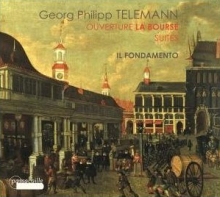One of the persistent pleasures in listening to whatever comes your way is that any random find may lead you to treasure. You pick up a stray gem, track its source, and suddenly uncover an entire vein of music as good.

It was like that for me with Georg Philipp Telemann’s orchestral suites. A chance encounter in the early ’90s — a disc by the English Concert (now out of print) — sent me scurrying around for more. And more there certainly is. Between Telemann’s own incredible production (estimates of the number of suites run as high as a thousand, though the Telemann catalogue [TWV] stops well short of 200) and ensembles’ continuing hunger for good music, what was a backwater some 20 years ago is practically its own territory now. And it has this advantage over many other less-explored byways of the Baroque: You’re pretty well guaranteed to find something that charms you.
It’s hard to pin down the Telemann-orchestral-suite magic. I think the essence is that every movement has a sharply defined character, and none lasts a bit longer than it needs to. They are brief, deft sketches, drawn with few but cannily chosen lines.
For the true Telemaniac, the ongoing series on Brilliant Classics by the Collegium Instrumentale Brugense — a modern-instrument, but stylish, band — is indispensable, if only because it covers so much music. Yet it’s the period-instrument bands that best know how to have fun here.
Listen to the Music
L'Espérence De Missisippi
Suite In C Major III:
Les Étudiants Gaillards
Il Fondamento, the Baroque orchestra founded by oboist Paul Dombrecht more than two decades ago, has been turning out lively recordings of 18th-century music ever since — from the obvious (Vivaldi and Albinoni oboe concertos, early Mozart symphonies) to the offbeat (Fux, Fasch, Zelenka, Heinichen, Abel). Its first disc of Telemann suites featured biggish pieces, with quadruple woodwinds or with horns. The present disc (a reissue of a recording from 1996), titled La Bourse after one of the suites, is more modest: just two oboes, bassoon, and strings.
A bourse is a stock exchange. Telemann spent nearly a decade of his composing career living in an upper corner of a massive Frankfurt mansion whose ground floor was then occupied by the Frankfurt Bourse. The title La Bourse isn’t actually Telemann’s, having been attached to the piece (TWV 55:B11) by a 20th-century editor, but as musicological conjectures go it’s not that much of a stretch. The last movement is titled “L’Espérance de Mississippi” — presumably the “Mississippi bubble” of 1720, when thousands of investors staked their hopes (unwisely) on French Louisiana.
When you consider that the other movements are titled “Interrupted rest,” “War in peacetime,” “The victors vanquished,” and “Solitude in company,” it’s hard to resist the idea that this is Telemann’s portrayal of a stockbroker’s life. All the same, there’s little that you could call tone-painting in this suite. Telemann trying deliberately to imitate something, be it a frog or an old woman, almost never misses. These titles (apart from Le Repos interrompu, which is exactly what it sounds like) seem added after the fact.
The other two suites here don’t pretend to illustrate anything but themselves. One (TWV 55:g3) is a sort of expansion of an earlier chamber piece. There are six movements in a row, titled “Aria,” so sharply distinct that apart from the common key you wouldn’t necessarily assume they all belonged to the same piece. The other (TWV 55:C4) is a big (10-movement) suite in as grand a style as can be achieved with so small an ensemble.
It’s typical Telemann in the sense that it delivers what was promised, and then throws in a little bonus. You’ve got your dance movements (the canonical allemande, courante, sarabande, plus some extras); but you’ve also got a rambling “Air italien,” an “Entrée,” and a gavotte titled “Les Étudiants gaillards” (roughly, “the lively students”). This last is a hoot. The main gavotte is decorous enough, but the trio section involves oboes in octaves over a bassoon drone, to which Dombrecht has added some most apt percussion.
The performances — nimble, suave, witty, and somber by turns — range as widely as the music does, and run in felicitous tandem with it. There is grander and more elaborate music (as well as smaller and humbler music) in the Telemannian sea; but this is as good a place as any to dip a toe in.

